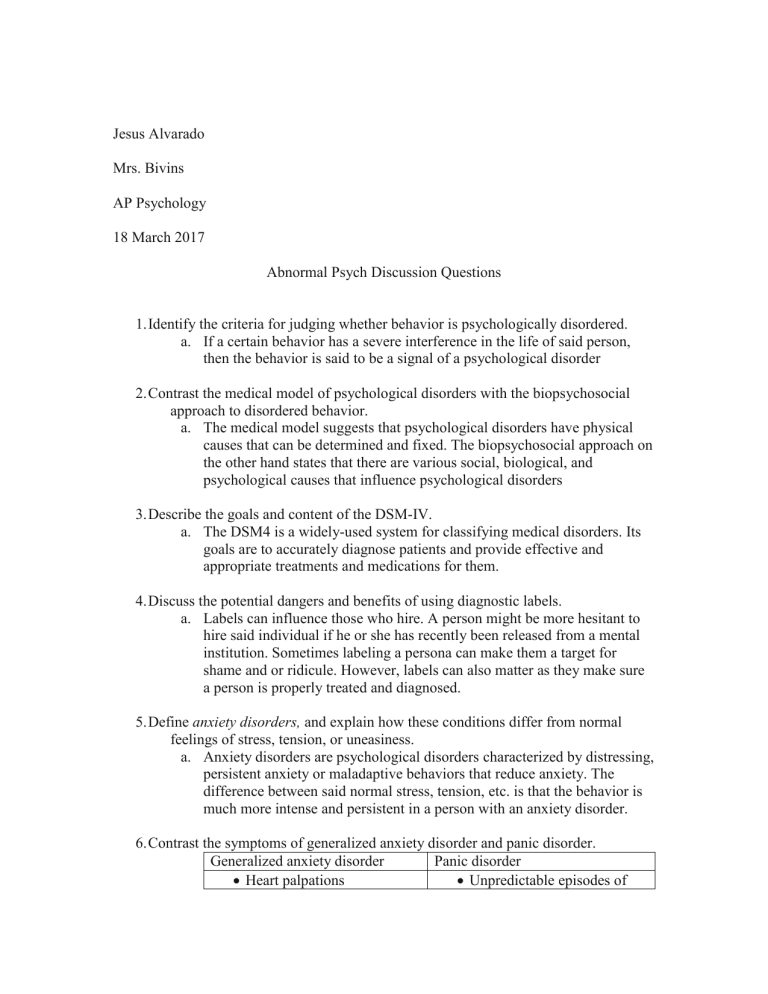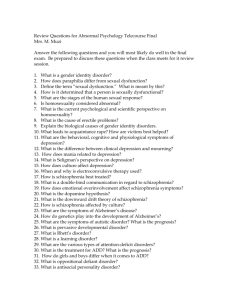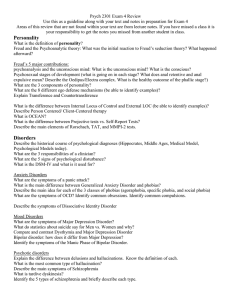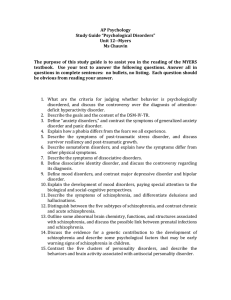
Jesus Alvarado Mrs. Bivins AP Psychology 18 March 2017 Abnormal Psych Discussion Questions 1. Identify the criteria for judging whether behavior is psychologically disordered. a. If a certain behavior has a severe interference in the life of said person, then the behavior is said to be a signal of a psychological disorder 2. Contrast the medical model of psychological disorders with the biopsychosocial approach to disordered behavior. a. The medical model suggests that psychological disorders have physical causes that can be determined and fixed. The biopsychosocial approach on the other hand states that there are various social, biological, and psychological causes that influence psychological disorders 3. Describe the goals and content of the DSM-IV. a. The DSM4 is a widely-used system for classifying medical disorders. Its goals are to accurately diagnose patients and provide effective and appropriate treatments and medications for them. 4. Discuss the potential dangers and benefits of using diagnostic labels. a. Labels can influence those who hire. A person might be more hesitant to hire said individual if he or she has recently been released from a mental institution. Sometimes labeling a persona can make them a target for shame and or ridicule. However, labels can also matter as they make sure a person is properly treated and diagnosed. 5. Define anxiety disorders, and explain how these conditions differ from normal feelings of stress, tension, or uneasiness. a. Anxiety disorders are psychological disorders characterized by distressing, persistent anxiety or maladaptive behaviors that reduce anxiety. The difference between said normal stress, tension, etc. is that the behavior is much more intense and persistent in a person with an anxiety disorder. 6. Contrast the symptoms of generalized anxiety disorder and panic disorder. Generalized anxiety disorder Panic disorder Heart palpations Unpredictable episodes of Agitated worriedness Sweaty palms Persistent (ex. Symptoms last for years) intense dread Shortness of breath Choking Trembling numbness a. 7. Explain how a phobia differs from the fears we all experience. a. Many people have fears that bother them. Yet, in some people those same fears bother them to the point they avoid said object, activity, or situation completely. Some fears may disappear forever for some people but an individual who has a phobia may have said fear for years. 8. Describe the symptoms of obsessive-compulsive disorder. a. Repetitive unwanted actions such as washing hands, checking gas valves, etc. Obsessions such as having things in symmetry, order, or exactness. 9. Describe the symptoms of post-traumatic stress disorder, and discuss survivor resiliency. a. PTSD symptoms include nightmares, insomnia, social withdrawn and severe anxiety. Many people experience a traumatic event in their lifetimes but only about 1 in 10 of those who do develop PTSD. This is known as survivor resiliency as it shows how survivors of such events can fight back those depressing thoughts. 10. Discuss the contributions of the learning and biological perspectives to our understanding of the development of anxiety disorders. a. The learning perspective views anxiety disorders as a product of fear conditioning, stimulus generalization, reinforcement of fearful behaviors, and observational learning of others’ fear. The biological perspective helps people see why we learn some fears more readily and why some individuals are more vulnerable. Emphasizes is placed in evolutionary, genetic, and physiological influences. 11. Describe the symptoms of dissociative disorders, and explain why some critics are skeptical about dissociative identity disorder. a. Symptoms of DID include sudden loss of memory or change in identity. The disorder became so popular in the late twentieth century and it is not found in many countries and is very rare in others. These facts have raised suspicions amongst psychologists and skeptics of DID. Skeptics argue that the condition is either contrived by fantasy-prone, emotionally variable people. 12. Define mood disorders, and contrast major depressive disorder and bipolar disorder. a. Mood disorders are disorders that are characterized by emotional extremes. Major depressive disorder Symptoms such as recurring thoughts of suicide, insomnia, fatigue, loss of appetite, depression, physical agitation are present and last for 2 or more weeks. Usually five or more symptoms are present in a person with MDD. Bipolar disorder A disorder in which a person switches, usually from week to week, from a depressed state to a “manic” state. A person in a manic state may be overtalkative, elated, and overactive. b. 13. Discuss the facts that an acceptable theory of depression must explain. a. Many behavioral and cognitive changes accompany depression i. May depressed people think of bad thoughts and are more sensitive to negative information. Usually such accompaniments disappear after the mood lifts b. Depression is widespread i. Suggests its causes must be common c. Most depressive episodes self-terminate i. Most people who suffer from terrible return to normal without the help of a professional d. Stressful events related to work, marriage, etc. often precede depression i. The death of a love one, loss of a job, marital crisis often increase the risk of depression e. Depression strikes earlier than ever with each new generation i. Teens are reporting now more than ever symptoms of depression 14. Summarize the contributions of the biological perspective to the study of depression, and discuss the link between suicide and depression. a. The risk of getting depression increase if your family has a history of having depressive disorders. If you suffer from a depression disorder, chances are one of your closer relatives also suffers from depression. Depression has been shown to be a leading cause of suicide. The risk of suicide is five times greater if the person is depressed. 15. Summarize the contributions of the social-cognitive perspective to the study of depression, and describe the events in the cycle of depression. a. Such a perspective has allowed researchers to explore the roles and thinking of a depressed person. Negative thoughts and negative moods have been shown to interact. A stressful event such as a breakup can lead to overthinking which leads to a depressed state that influences the way a person thinks and in turn fuels stressful experiences such as internal rejection. 16. Describe the symptoms of schizophrenia, and differentiate delusions and hallucinations. a. Schizophrenia-disorder characterized by delusions, hallucinations, disorganized speech, and/or inappropriate emotional expression b. Delusions are false beliefs such as being chased or watched. Hallucinations are false sensory experiences such as seeing something like a pizza move when in fact the pizza never moved. 17. 18. 19. Distinguish the five subtypes of schizophrenia, and contrast chronic and acute schizophrenia. a. Catatonic – little to no movement, possibly a vegetative state b. Disorganized – common archetype of schizophrenia; disorganized thinking, flat effect, inappropriate emotions or behavior c. Paranoid – common archetype of schizophrenia; delusions, hallucinations, false beliefs of grandeur d. Residual – long-term schizophrenia where most symptoms have disappeared, negative symptoms (detractions from normal behavior) often remain such as flat effect or a refusal to talk e. Undifferentiated – does not fit in one of the above categories because the patient suffers from symptoms of multiple types f. Acute schizophrenia is when a person who was previously healthy starts to display odd behavior and develops symptoms of schizophrenia over a short period. Acute schizophrenia can turn into chronic schizophrenia which is a long-term state of schizophrenia Outline some abnormal brain chemistry, functions, and structures associated with schizophrenia, and discuss the possible link between prenatal viral infections and schizophrenia. a. Researchers have linked certain forms of schizophrenia with brain abnormalities such as increased receptors for the neurotransmitter dopamine. Modern brain scanning techniques indicate that people with chronic schizophrenia have abnormal activity in multiple brain areas. A possible cause of these abnormalities is a pregnancy viral infection that impairs fetal brain development. If their country suffered a flu epidemic, then said people are more likely to develop schizophrenia. Discuss the evidence for a genetic contribution to the development of schizophrenia. a. The nearly 1-in-100 odds of any person developing schizophrenia become about 1 in 10 if a family member has it, and close to 1 in 2 if an identical twin has the disorder. Adoption studies confirm the genetic contribution to schizophrenia. For example, if a child has a schizophrenic parent then his chances of developing schizophrenia are increased. 20. Describe some psychological factors that may be early warning signs of schizophrenia in children. a. Some warning signs of schizophrenia development may be a mother whose schizophrenia was severe and long-lasting, birth complications, short attention span and poor muscle coordination, disruptive or withdrawn behavior, emotional unpredictability, solo play, etc. 21. Contrast the three clusters of personality disorders, and describe the behaviors and brain activity associated with antisocial personality disorder. a. One cluster expresses anxiety, a second cluster expresses eccentric behaviors, and a third exhibits dramatic or impulsive behaviors. Antisocial personality disorder is a disorder in which a person exhibits a lack of conscience for wrong-doings. Such people tend to be very aggressive and unsympathetic. Brain scans of such individuals with this disorder have revealed reduced activity in the front lobes, an area of the cortex that help control impulses and reactions. 22. Discuss the prevalence of psychological disorders, and summarize the findings on the link between poverty and serious psychological disorders. a. One in seven people has, or has had, a psychological disorder during the prior year. The most common disorders in the United States are alcohol abuse, phobias, and mood disorders. Those who experience a psychological disorder usually do so by early adulthood. Poverty can be used to predict a mental disorder. Poverty can precipitate disorders, especially depression in women and substance abuse in men, some disorders, such as schizophrenia, can also lead to poverty.




